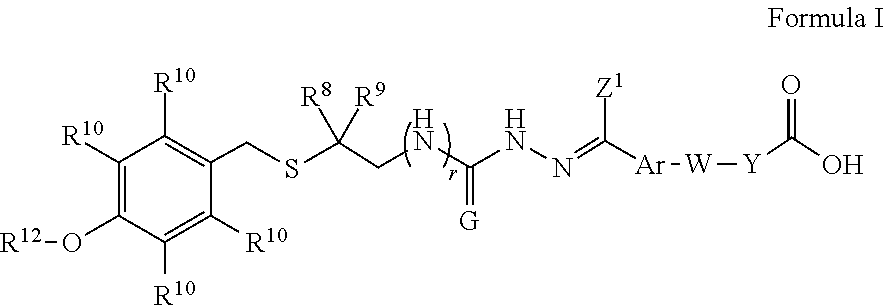Intermediates and methods for synthesizing calicheamicin derivatives
a technology of calicheamicin and derivatives, applied in the field of intermediates and methods for synthesis of calicheamicin derivatives, can solve the problems of low yield and quality, and achieve the effect of improving the yield of the resulting calicheamicin derivative and the yield of the reaction
- Summary
- Abstract
- Description
- Claims
- Application Information
AI Technical Summary
Benefits of technology
Problems solved by technology
Method used
Image
Examples
example 1
3-(4-methoxybenzylthio)-3-methylbutanoic acid
[0277]
[0278]85 g of 1 and 255 mL of 2-Methyltetrahydrofuran were added to a reactor at 20-25° C. 125.05 g of 2 was added to the reactor and the reactor was degassed by bubbling a nitrogen stream into the stirred solution for 15-20 min. Tetrabutylammonium fluoride (1M in THF, 0.05 equiv., 36.1 mL) was added to the reactor and the reaction was maintained at 20-30° C. for 2 hours.
[0279]A solution of calcium chloride dihydrate (0.35 equiv., 28.060 g) in 255 mL of water was added. After stirring for 20 minutes the lower aqueous phase was removed. To the upper organic phase was added 252 mL of methanol and 3 equiv. of NaOH in 252 mL of water. The reaction mixture was stirred until complete consumption of the intermediate ester (3) is observed.
[0280]The reaction was cooled to 15° C. and 2-methyltetrahydrofuran was added (252 mL) followed by 252 mL of water. Concentrated HCl was added (3.1 equiv., 184 mL) slowly, maintaining the reaction in the r...
example 2
3-(4-methoxybenzylthio)-3-methylbutanehydrazide
[0282]
[0283]Acid 4 (81.67 g, 321 mmol) was added to 375 mL of THF (tetrahydrofuran). CDI (1.05 eq., 54.7 g) was charged in three portions and the reaction was stirred at 20° C. for 2.5 hours. In a separate reactor a solution of hydrazine monohydrate (2.5 equiv., 40.19 g) in 200 mL of THF was prepared. The solution of intermediate 5 was added to the hydrazine hydrate solution keeping the internal temperature at 20° C. After the addition was complete the reaction was stirred for 18 hours, then concentrated to 100 mL. 850 mL of EtOAc (ethyl acetate) was added, and the solution was washed 3 times with 500 mL of water then 200 mL of brine. The organic layer was dried with Na2SO4, filtered through diatomaceous earth and concentrated on a rotary evaporator to a white slurry. 300 mL of heptane was added and 200 mL was removed on a rotary evaporator. Another 200 mL of heptane was added and stripped to a thick white slurry. The mixture was filter...
example 3
4-(4-(1-(2-(3-(4-methoxybenzylthio)-3-methylbutanoyl)hydrazono)-ethyl)phenoxy)butanoic acid
[0284]
[0285]68 g of 6 and 57.43 g of 7 were added to 680 mL of methanol (MeOH). 68 mL of acetic acid (HOAc) was added and the mixture was heated at 45° C. for 3 hours, cooled to 20° C., and held for 16 hours. The slurry was filtered, washed with methanol and dried. 112.60 g of the title compound 8 as a mixture of E and Z isomers was obtained. 1H NMR (DMSO-d6): δ (ppm) 1.5 (m, 6H), 2.0 (m, 2H), 2.2 (m, 3H), 2.4 (m, 2H), 2.7 (s, 1.1H), 3.0 (s, 0.9H), 3.7 (m, 3H), 3.8 (m, 2H), 4.0 (m, 2H), 6.8 (m 2H), 6.9 (m, 2H), 7.3 (m, 2H), 7.7 (m, 2H), 10.2&10.3 (s, 1H), 12.1 (s, 1H). LC-MS m / z 473 [M+H]+.
PUM
| Property | Measurement | Unit |
|---|---|---|
| temperatures | aaaaa | aaaaa |
| concentration | aaaaa | aaaaa |
| concentration | aaaaa | aaaaa |
Abstract
Description
Claims
Application Information
 Login to View More
Login to View More - R&D
- Intellectual Property
- Life Sciences
- Materials
- Tech Scout
- Unparalleled Data Quality
- Higher Quality Content
- 60% Fewer Hallucinations
Browse by: Latest US Patents, China's latest patents, Technical Efficacy Thesaurus, Application Domain, Technology Topic, Popular Technical Reports.
© 2025 PatSnap. All rights reserved.Legal|Privacy policy|Modern Slavery Act Transparency Statement|Sitemap|About US| Contact US: help@patsnap.com



